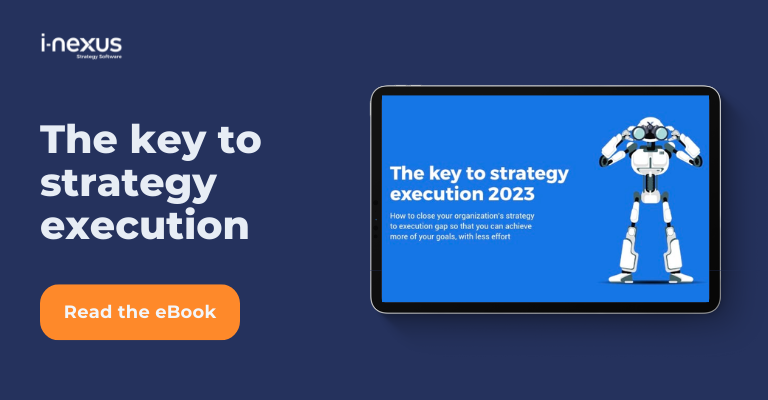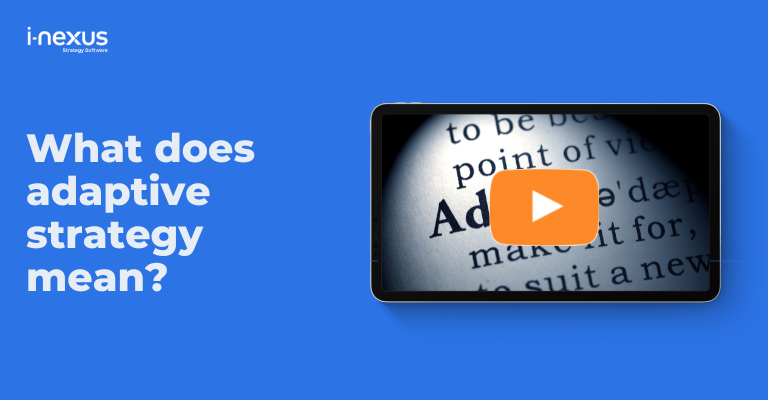What is a strategy without its effective implementation, precise execution and measured review? One could argue nothing. For a strategy is a sum of its parts, hence the phrase Strategy Execution Management. Here’s what your business needs to know about mastering the conveyor belt process of managing and executing your strategy.
Written by: Deborah Biscomb, Head of Marketing
Is strategy something created behind closed doors? Is it simply getting results, regardless of how the destination is reached? Or do you even need a strategy to be successful as a business?
Indeed, there have been successful companies throughout the last 100 years who have reached great heights because they aligned their product with the right present and latent needs.
However, the rarity of success without a strategy is minimal.
Would Uber have captured the hearts and minds of millennials had it not been for the apparent failings of traditional taxi services? Would Blockbuster have survived but for the advent of superfast broadband speeds?
Could these businesses have had very different fates?
The answer is yes. And that isn’t necessary due to market conditions, internal resources or product development. It is a resounding yes because every organization has the power to succeed within its reach.
Unfortunately, that opportunity is not always grasped. Lack of resources, focusing on the wrong KPIs and strategic visions can lead even the greatest business astray.
Commercial success is akin to any venture we take in life – assessing what we want to achieve based on our skills and opportunities, setting goals, ensuring we have the resource to act on these goals, measuring our performance, and optimizing.
That is the essence of Strategy Execution Management.
Whether you are a seasoned Chief Strategy Officer or starting in the world of project management, this is all you’ll need to know about the process of Strategy Execution Management in 2021 and beyond.
It all begins with patience
“Patience is a key element of success.”
Bill Gates
Patience is a rare commodity today. In a world where we can order food from the comfort of our own home and you can order a couch and have it delivered the next day, instantaneous gratification is the norm.
This consumer mindset has bled into the world of business.
Venture capitalists and Wall Street often buy and sell at the drop of a hat based on short-term booms or busts all. It has put our business leaders in a place where success is expected almost immediately.
At some stage patience became a lost art.
Patience is walking the line of process, action and results – not just getting results. Strategy Execution Management is a never-ending conveyor belt of these elements.
Planting the seeds - strategy formulation
Step one is where the seeds are planted – strategy formulation.
Strategic planning begins with conceptualizing and determining the way that you can achieve your organizational objectives and meet your vision and mission.
The strategy is a map identifying where you are and where your journey ends.
That end is a future-state where you are perhaps the market leader, you’ve increased market share, or you’ve digitalized your entire business.
Here you are making what are, quite honestly, fundamental decisions on the products, services and internal step-changes which will help you realize that future state.
What are the ingredients to ensuring that over a defined period (2-5 years) we are positioned effectively in our external environment?
Your business will be set breakthrough / stretch goals / objectives which will push you beyond your existing performance.
It will consider the most effective means to creating benefit for your current and future customers, and therefore ‘stickiness’ to your brand.
You’ll also be mindful of how to measure progress and note breaking points, those levels of performance, external factors or even force majeures (see COVID-19) which render the strategy null and void.
The entire process of strategy formulation will involve key people across your organization, leveraging them in the creation of your strategy and securing buy-in and shared responsibility for its implementation, execution and review.
Stocking up on resources - strategy implementation
Strategy implementation is the second stage in the conveyor belt.
It takes the strategy from a conceptual direction and seeks to define the resources, pressures and other factors which must be borne in mind for successful execution.
Implementation is divided into three phrases and a series of questions within:
a) Project, procedure and resource
- What projects are needed?
- What procedures are required to inform and direct teams?
- What resources (financial, human and systems) will be called upon?
b) Structure and leadership
- Is our organizational structure the optimal structure for strategic success?
- Is our headcount enough for the strategy, do we have the right skills and should we look to outsource / invest in more people?
- Do our leaders know how to engage, inspire and direct the teams needed for this to be a successful execution?
- Can we balance the project portfolio to make use of all available resource and knowledge?
- Do we need to sacrifice / downgrade the importance of particular projects?
- What are the metrics we need to track for early warning?
- How will we communicate the strategy, progress and reward positive results?
Effective implementation after formulation is a critical responsibility of leaders.
A fantastically designed strategy which doesn’t fit to operational realities or possibilities is nothing more than a collection of paper, ink, words and intellectual brain power.
Leaders positively communicating and engaging with the business as to the strategy will enhance the likelihood of success.
When teams know of the direction, the goals, the projects involved and how progress will be measured there is transparency, and therefore a greater chance of support of the strategy and its successful execution.
Bringing strategy to life - strategy execution
“Whether a company wins or loses in the marketplace is directly attributable to the quality of a company’s strategy and the proficiency with which the strategy is executed.”
Miller et. al., 2002
Having formulated a strategic direction and assessed the necessities for effective implementation, attention must shift to execution – that is the day in and day out operational management of your strategy.
Your strategic plan may be a static a structure for your 2-5 year focus, but external environments change, funds can deplete or be replenished based on revenue and operating expenditure, and staff will, much like the sea, ebb and flow in and out of your organization.
Strategy execution concerns itself with the operational realities of your strategy.
It is many things – operational management, continuous improvement, project management, balancing and optimizing portfolios and shepherding resource.
It is taking the data in front of you and having the courage to make decisions which keep your execution on track, and knowing when to act when decisions require counter-measures.
And it is not simply a concern of CEOs and CSOs.
In a Deloitte report of the main concerns that CFOs feel their business face, execution features highly.
Their solution revolves around the strategy execution phase of Strategy Execution Management:
“By investing in helping individuals develop the new competencies required by the strategy, the dynamic approach increases the likelihood that the implementation effort will not be a temporary, isolated event.
Rather, the effort results in a sustained, long-term improvement in the organization’s performance.”
PDCA and strategy execution management
The process of strategy execution can be summarized in six stages which bear resemblance to Deming’s classic Plan-Do-Check-Act structure (PDCA):
1) Communicating your organizational focus
With your strategy formulated it is important to communicate this focus, providing focus on what the collective and individual will be tasked with achieving, enabling greater alignment and accountability.
2) Aligning and securing accountability to the strategy
Focus sets the stage for securing alignment to the vision and strategic plan.
By demonstrating to business units and individuals their role in executing your strategy, as well as providing the tools to communicate outside of their silos, you will create a culture of responsibility and community which drives success.
3) Cascade and negotiate goals across the organization which feed your strategy
With focus and a sense of community and accountability, your organization must now adopt communication techniques such as the catchball process to allow for the formulation and negotiation of objectives, sub-objectives and improvement priorities.
The successful cascade of your goals and objectives to their corresponding owners is achieved by promoting a culture of communication, with open dialogue and participation in goal setting fostering transparency and increased likelihood of strategy realization.
4) Measure your results using KPIs which provide clarity on your strategic performance
Identify the metrics and Key Performance Indicators (KPIs) which are central to your strategy and their corresponding objectives and initiatives.
Typically, these will follow the SMART technique (Specific, Measurable, Achievable, Relevant and Time-bound).
Measuring the performance of your portfolio of initiatives ensures that they remain in-line with your strategic goals, meaning you can confidently answer questions around progress to date and whether you are on-track to succeed.
5) Taking corrective actions
With KPIs set and a process around checking actual vs. expected performance, you will be equipped to take corrective action in a rapid, effective manner based on data, as opposed to sole instinct.
By adopting rigorous reporting processes and having systems in place to measure results, you can safeguard your transformation efforts with the knowledge of what has caused deviation from expected results, such as unrealistic objectives or insufficient resource allocation, and implement the appropriate changes.
6) Re-measuring and improving
Having identified and set corrective actions in motion, the final step of the strategy deployment process is to re-measure and, once more, improve where appropriate.
This closed-loop of planning, acting, measuring and improving is what underpins the successful execution of transformation programs.
The lessons learned from the deployment and execution of the strategy will then be used to inform goal setting and portfolio management in the next planning and execution cycle.
Mastering the process
Whether we consider Strategy Execution Management a conveyor belt or mirroring Deming's PDCA model, one constant remains - commercial success, breakthrough performance and all that is involved in the inspirational stories of the world's greatest organizations is created out of discipline, rigor and passion.
And a dash of patience.
We began our overview with a quote from Bill Gates which, in the light of this blog, seems more important than ever.
It is because with these ingredients your business can approach the conveyor belt of strategic management with eyes wide open, ready to thoroughly take its vision all the way through to execution.
Continue learning about Strategy Execution Management
Click here to visit our Strategy Execution Management knowledge hub, filled with content to support you in embracing the 'no normal' of strategy in the 2020s and beyond, or explore these recommendations:
- The Hoshin Kanri X-Matrix: The What, How, Why, Benefits and more: Discover how the X-Matrix works and how you can make your own in our free Excel template
- Danaher, Ingersoll Rand and Xerox: Policy Deployment in Practice: Learn why the experiences of these companies can teach us a lot about adopting Policy Deployment / Hoshin Kanri.
- Download our Hoshin Kanri eBook: Read how Hoshin Kanri is supporting organizations to drive great business results, how two businesses have used the methodology to build their business systems, case studies and more.
About the author
Deborah Biscomb is Head of Marketing at i-nexus. Deborah has wide-ranging experience of markets such as retail, manufacturing, financial services, public sector, telecommunications, energy and utilities, distribution and logistics.
As Head of Marketing, her drive is to raise awareness and understanding of the challenges facing enterprises in controlling their strategy and driving superior results.
If you’d like to talk more about Strategy Execution, reach out to Deborah on deborah.biscomb@i-nexus.com or connect with her on LinkedIn for the latest strategic insights.




